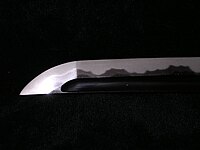Differential hardening

Differential hardening is a process of making metal (usually steel) harder in some areas than others. This is done by heating the metal to a very high temperature and then quickly cooling it in different ways, but only in certain places.
Imagine you have a big piece of metal that you want to make into a knife. The sharp edge of the knife needs to be very hard so that it can cut through things, but the rest of the knife doesn't need to be as hard. So you would use differential hardening to make the edge of the knife harder than the rest of it.
To do this, you heat up the entire piece of metal until it is very hot. Then you cool the edge of the knife very quickly by plunging it into cold water or oil. This process makes the edge of the knife very hard. But you don't cool the rest of the knife as quickly, so it is not as hard.
The reason this works is because different parts of the metal cool at different rates. When you cool the metal quickly, the molecules inside of it don't have time to arrange themselves properly. This makes the metal very hard, but also brittle and easy to break. So by controlling the cooling process, you can make some parts of the metal harder than others.
In summary, differential hardening is a way to make metal harder in some areas than others by heating it up and cooling it down quickly in different ways. This is a useful technique for making things like knives and swords, where only certain parts of the metal need to be very hard.
Imagine you have a big piece of metal that you want to make into a knife. The sharp edge of the knife needs to be very hard so that it can cut through things, but the rest of the knife doesn't need to be as hard. So you would use differential hardening to make the edge of the knife harder than the rest of it.
To do this, you heat up the entire piece of metal until it is very hot. Then you cool the edge of the knife very quickly by plunging it into cold water or oil. This process makes the edge of the knife very hard. But you don't cool the rest of the knife as quickly, so it is not as hard.
The reason this works is because different parts of the metal cool at different rates. When you cool the metal quickly, the molecules inside of it don't have time to arrange themselves properly. This makes the metal very hard, but also brittle and easy to break. So by controlling the cooling process, you can make some parts of the metal harder than others.
In summary, differential hardening is a way to make metal harder in some areas than others by heating it up and cooling it down quickly in different ways. This is a useful technique for making things like knives and swords, where only certain parts of the metal need to be very hard.
Related topics others have asked about:
